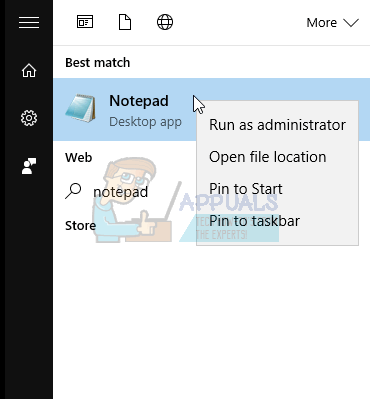This message usually appears when you’re trying to copy a file, such as a text file, or create one, inside one of the root folders of the partition where your operating system is installed. These folders are usually Program Files, Windows and System32, and seeing as they are the most important folders for Windows to work properly as a piece of software, you will understand why Microsoft have placed such a protection. However, there are certain situations where you simply need to have that specific file in that specific folder, and it is good to know that there are a few ways that you can go about solving the 0x800700522 issue. The first and second methods are absolutely safe, but the others require editing the permissions and accessibility of your computer, so you might want to do a system restore point before you start.
Method 1: Save file as administrator
This is the easiest method of all, and it overrides Microsoft’s limitations for the root folders of the OS’s partition. It, however, depends on the type of file you’re trying to save. Instead of creating the file in the folder, or copying it from another location, you can save it as an administrator. If it’s a text file, open Notepad or your text editor of choice, if it’s an image, open it from within Photoshop, etc., but run the program as an administrator. Whichever the program you need to create the file, you can right-click the executable file and select Run as Administrator from the menu. This will give the software in question higher permissions than a regular run, and you can save your file inside the root folders without any problems.
Method 2: Copy the file using an elevated command prompt
This method requires an elevated command prompt. You can open one by opening the Start menu, typing cmd, right-clicking the result and selecting Run as Administrator from the menu. You need to know the exact address of the source file, and the destination you need, and the command is: For example, if we want to move a Test.txt file, found in the Work folder on the D: partition, to the Windows folder in the C partition, the command would be as follows: Your file should be copied to the destination successfully.
Method 3: Disable The Admin Approval Mode
User Account Control can cause numerous problems for a user who isn’t that tech-savvy and needs basic functionality from his/her computer. The UAC’s Admin Approval Mode can lock down a number of functions that you may need from your computer, including the one to create or copy a file inside the root folders. Disabling it is fairly easy, and requires you to do a couple of easy steps. First, open the Run dialogue by pressing simultaneously Windows and R on your computer. Type secpol.msc and press Enter. Press OK if a dialogue appears. Within the Local Security Policy window, you will see a navigation pane to the left. Navigate to Local Policies, and then click on Security Options. Scroll down in the right navigation pane until you find User Account Control: Run all administrators in Admin Approval Mode. Right-click it, select Properties, and set it to Disable. Click Apply, then OK, and close the Local Security Policy window. Restart your computer in order for it to save the changes. When it boots up, you should be able to create the file where you need it.
Method 4: Completely disable User Account Control
If all else fails, your last resort is to completely disable Windows’ UAC. This is done from the System Configuration panel, which you can access by typing msconfig in the Start menu. Click on the Tools tab, find Change User Account Control Settings and press Launch. Set the UAC to Low/Off. Click OK and close the System Configuration panel by pressing OK again. Restart your device in order to apply the change manually, even though when closing the System Configuration panel you should be met with a message to restart it. After rebooting, you should be able to create the file where you need it.
Method 5: Take ownership of the operating system’s partition
Taking ownership of the partition will give you full control over it. We will take C: as the partition in question, however if you have installed your operating system on a different partition, apply the steps to it instead. The first thing to do is open This PC or My Computer, and right-click the C drive, then select Properties from the menu. Go to the Security tab and click Advanced, and then the Owner tab. Within the Name list, click on your user name, or Administrator if that’s what you’re logged in with, or the Administrators group. Click Edit, and check Replace all existing inheritable permissions on all descendants with inheritable permissions from this object. You will be greeted with a message that asks you if you want to continue, click Yes. Now you have complete ownership of the partition and you can copy whatever you want inside. Whichever of the aforementioned steps you take, you should be able to copy or create the files you need, exactly where you need them, thus bypassing Windows’ security limitations.
Fix: Required privilege is not held by the client (on Executables)How to Fix Windows Update Error 0x80070522Fix: Unable to Correct Problems ‘You have Held Broken Packages’PlayStation Showcase To Be Held Later This Month; According to Rumors

